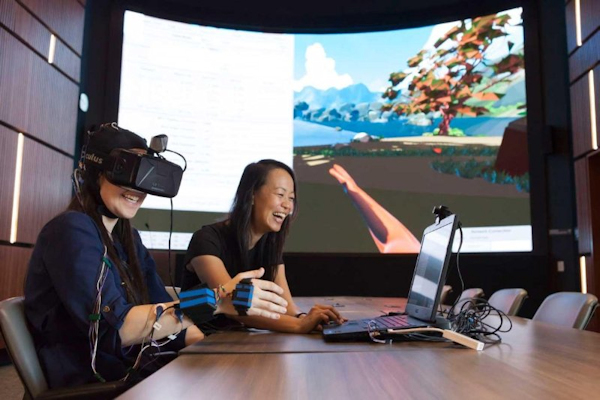[“If you give someone a healthy body in VR, will that help them recover their health?” Researchers at USC are investigating the potential of VR and presence to promote brain plasticity and recovery in stroke survivors, with encouraging early results. This story is from CNET; for more information including a 4:35 minute video see earlier coverage from USC News. –Matthew]

VR could trick stroke victims’ brains toward recovery
Researchers at the University of Southern California are examining how virtual reality could promote brain plasticity and recovery.
By Abrar Al-Heeti
October 15, 2017
Could virtual reality help stroke survivors regain motor function?
That’s a question Sook-Lei Liew is looking to answer.
Liew, an assistant professor at the University of Southern California and an affiliate of the Stevens Neuroimaging and Informatics Institute at the Keck School of Medicine, was inspired by research from Mel Slater and Jeremy Bailenson on embodiment in VR. If someone’s given a child’s body in VR, for example, they might start exhibiting more childlike behavior.
She wondered if giving stroke survivors with motor impairments a virtual avatar that moves properly could help promote brain plasticity (or the ability to change) and recovery. Maybe it would eventually lead to them to moving an impaired limb again.
“So, kind of like tricking the brain through visual input,” said Liew, who is also director of the Neural Plasticity and Neurorehabilitation Laboratory. “There’s a lot of emerging evidence from neuroscience and psychology that was showing that you can really identify [with the avatar], and it changes your behavior based on the avatar you’re given in VR.”
Virtual reality is a computer-generated simulation of a 3D environment. Using a VR headset with lenses that feed images to the eyes, a person can be virtually transported to another location, or interact with a setting in a seemingly realistic way. It’s commonly been used in gaming, but it’s being tested in other environments, too — like rehab.
Implementing VR in health care and patient treatment isn’t new. It’s been used to help people overcome phobias and anxiety disorders. But the application is starting to take off now that the technology is more developed and commercially available. Some medical schools are looking to train students with virtual simulations, and it’s even helping midwives learn how to deliver babies.
Liew’s research team has been working on a study for about two years called REINVENT, an acronym for Rehabilitation Environment using the Integration of Neuromuscular-based Virtual Enhancements for Neural Training. The researchers also collaborated with the USC Institute for Creative Technologies to develop the prototype.
The process works by using a brain-computer interface, which takes a signal from the brain and uses it to control another device: a computer, a robot or, in REINVENT’s case, an avatar in VR.
Next, researchers read electrical signatures of brain activity from the surface of the scalp using electroencephalography, or EEG, for short. The team also uses electromyography, which studies the electrical activity of the muscles. That can tell them whether somebody’s moving or if they’re trying to move.
Those signals are then fed into a program on a laptop. The program has thresholds so that when specific signals in the brain or muscle activity that correspond to an attempt to move are detected, they drive the movement of a virtual arm. The resulting visual feedback through a VR headset could help strengthen neural pathways from the damaged motor cortex to the impaired arm or limb.
While the researchers could theoretically extend this process to a patient’s lower limbs, Liew said it can be dangerous for someone with a motor impairment in the lower extremities to try to move with VR, so seated studies are much safer.
The research group recently finished testing the prototype using an Oculus DK2 with 22 healthy older adults, who provided a sample of what the brain and muscle signals look like when they move. They’re now starting to test with stroke patients in a controlled lab setting, aiming to work with 10 in the short term and hundreds in the long term, in both clinical and home environments.
The team also found that giving people neurofeedback of the virtual arm moving in a VR headset was more effective than simply showing it on a screen.
“Their brain activity in the motor regions that we’re trying to target is higher, and they’re able to control the brain-computer interface a little bit better and faster,” Liew said. “It makes the case that there is an added benefit from doing this in virtual reality, which is one of the first things we wanted to know.”
An unclear future
Because VR is still a relatively new technology, there are many unanswered questions on the best ways to use it in the medical profession.
“For the most part, nobody knows how to make great VR experiences, for business or consumer,” Gartner analyst Brian Blau said. “Over time, those issues will get resolved. But for the medical industry, they have the extra added bonus of having even more types of physical behaviors that they have to either mimic or want to measure.”
And while the possibilities for VR in health care are exciting, Liew is careful not to get ahead of herself.
“We think that VR is a promising medium, but we’re moving ahead cautiously,” she said. “A lot of the work that we’re trying to do is to test assumptions, because there’s a lot of excitement about VR, but there’s not that much that’s scientifically known.”
Only time — and plenty of research — will tell.